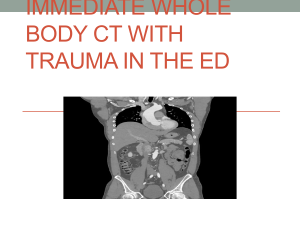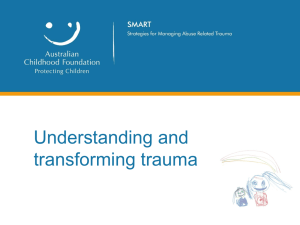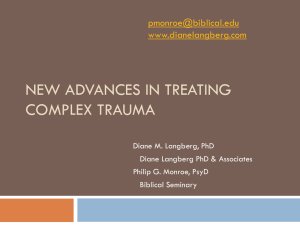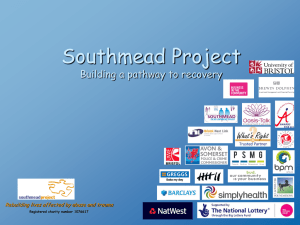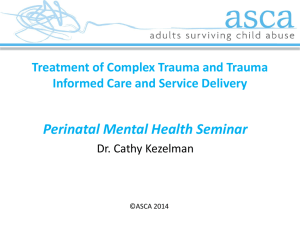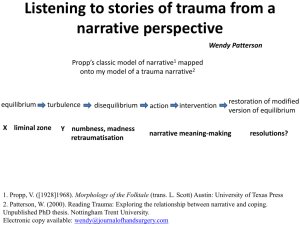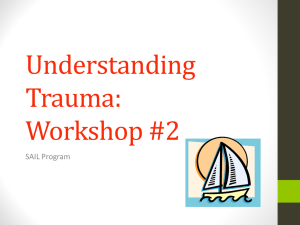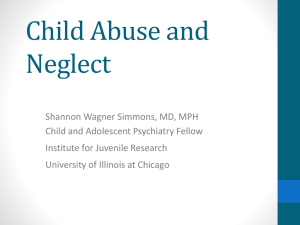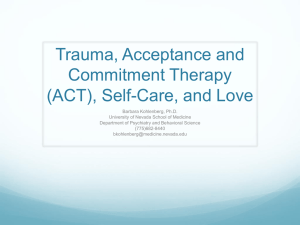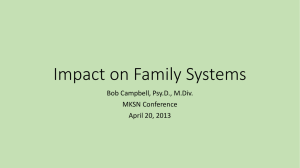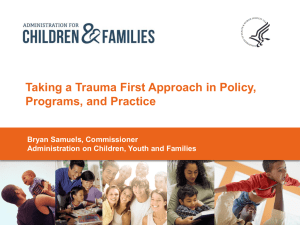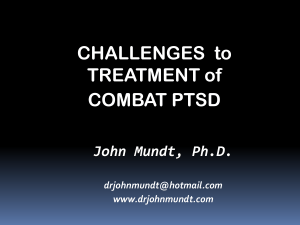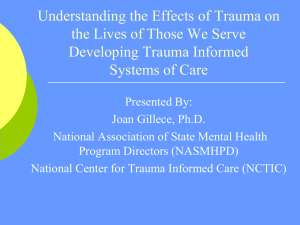Clergy Abuse: Betrayal and Relational Trauma
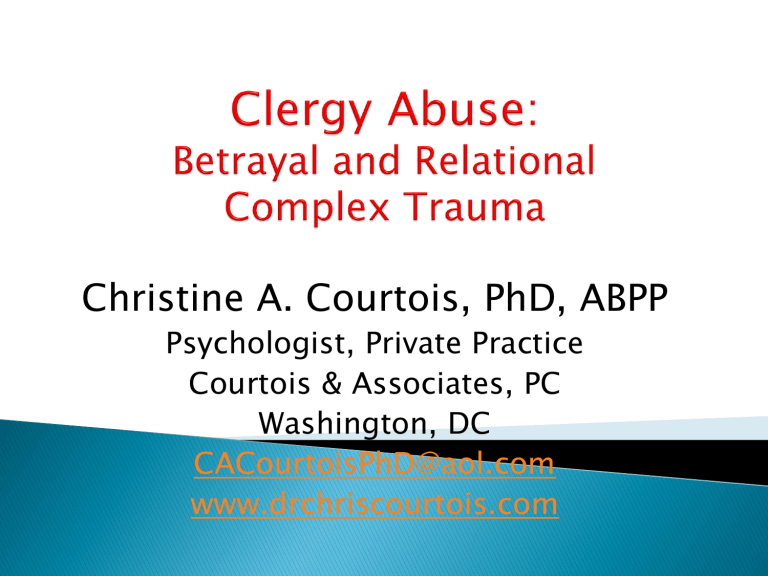
Christine A. Courtois, PhD, ABPP
Psychologist, Private Practice
Courtois & Associates, PC
Washington, DC
CACourtoisPhD@aol.com
www.drchriscourtois.com
I. Clergy abuse and incest have similar dynamics
◦ Both are forms of complex trauma
II. Complex trauma ->complex reactions
III. Complex reactions -> complex healing
◦ Understanding dynamics and common reactions helps to better understand the injury and to heal
What is trauma?
◦ Stressor event or experience (includes witnessing)
◦ Overwhelming
◦ Different types: impersonal, interpersonal, identity
What makes it traumatic?
◦ Overwhelming emotionally and cognitively
◦ Cannot be emotionally processed in the normal way
◦ When interpersonal, adds to the trauma
betrayal, secrecy, silence, taboo , force/violence, blame/shame, etc.
◦ Avoided and not processed
generalizes and/or goes underground
What is Complex Trauma?
◦ Interpersonal/identity
◦ Often during childhood/adolescence
Impacts development
◦ In context of a relationship
Betrayal/Misuse/Exploitation
Repeated/chronic
Entrapping
Escalating over time
Seriousness & intrusion
Sexual abuse by family members
(also by nonrelatives who have family roles, including clergy)
Violates primary relationships and roles
Violates responsibility to protect
Misuses authority, power, knowledge
Preys on and exploits those who are younger/smaller /less powerful/naïve/ immature/dependent/accessible
◦ Have fewer resources
◦ Victims are more vulnerable if family is not healthy
Betrayal and Relational Trauma
◦ Betrayal of an essential and sacrosanct relationship and role
◦ Not “stranger-danger”
◦ Much more emotionally conflicted and damaging
◦ May affect ability to remember
Second injury
Those who don’t respond or help
Institutional injury
Those that obstruct rather than help
Communities and organizations
Dysfunctional Family
◦ With boundary and power problems; sometimes violent, poly-abusive, addictions
Power and gender dynamics
◦ Patriarchal
Closed system
◦ Loyalty expected, even when not deserved
Family rules and injunctions
◦ Don’t!: know, feel, react, respond, tell
Paradox and hypocrisy
Victim who discloses is blamed, shunned, scapegoated,
◦ “You are with us or against us; Don’t ask us to admit/change”
Supporters/interveners are treated with suspicion, may be attacked
Secondary and tertiary victims
◦ Trauma has a wake : like a pebble in a pond
◦ Other family members, others in the parish or faith community
Structured power and historical behaviors
(including abuse) and doctrine
Patriarchal and hierarchical: Cardinals , bishops and priests as authority figures, extensions of the deity; contradictory views of women
Church as family
Church as closed system
Structured morals and beliefs (that are violated)
Structured training of priests
◦ Vocations and seminaries
◦ Personal and psychosexual development in the seminary
Loyalty and obedience expected
Priest as God’s representative: Spiritual
father
Authority and moral figure
May have a role in the child’s biological family
Always to be honored, obeyed, respected
Not to be questioned/suspected
Church and congregants as extended family
◦ Children of God
◦ Beliefs, structure, functioning
◦ Loyalty, attachment, kinship/faith ties
◦ Betrayal-trauma, hypocrisy, & disillusionment
Betrayal of role and responsibilities
Betrayal of beliefs and teaching
Ambivalent attachment/conflicted emotions/loyalty
◦ Second Injury
Enablers (housekeeper, other priests, etc.)
Passive bystanders (other priests, congregants, parents, Bishops, Cardinals, etc.)
Those who should help and don’t
Lack of investigation, follow-up, silencing
Disbelievers, blamers, scapegoaters, and attackers
◦ Vicarious injury: collateral damage
◦ Institutional Injury
Suppression of reports and inadequate investigation
Lack of reporting to criminal authorities
Lack of cooperation with investigations
Non-removal of perpetrators and moving them from one parish to another with no warning
Non-pastoral response to victims
Actively working against victims’ suits & rights
Statutes of limitation, bankruptcies, etc.
Expensive defense attorneys
Questioning of recovered or delayed memories
And the list goes on…
◦ “ Just get over it.”
◦ “What’s the big deal?”
◦ “All (litigating) victims want is money and to bankrupt the Church.”
◦ “It’s homosexuality and not pedophilia”
Can it not be one or the other or both?
◦ “The Church does not have to report to civil authorities.”
◦ “The problem is recent and it is over.”
◦ “Management systems are in place”
◦ “Why should I/we apologize for what other priests/Bishops did?”
Individual and subjective
Initial and short-term:
◦ Wide variety of behavioral, cognitive, emotional, physical/medical, identity, relational and family issues and symptoms
◦ PTS and PTSD, depression, anxiety, dissociation, substance abuse and compulsions
by victim’s age and stage of development
◦ May be noticed right away, but not understood
◦ Child may not disclose, even when asked directly
◦ Effects and symptoms may go dormant
Long-term:
Same: PTS and PTSD, Complex PTSD, dissociation, depression, anxiety, substance abuse
Episodic
Chronic
Again, manifested by age and stage
Delayed onset: Secondary elaborations of the untreated original effects
Cued by current events (positive and negative): media and other reports of clergy abuse; death of the perpetrator or others; feelings, thoughts, sensations; relationship and family issues; children and childrearing; response of others; institutional response, etc.
Major symptoms (the big three):
◦ 1. Re-experiencing
◦ 2. Numbing/detaching
◦ 3. Hyper-arousal
Associated symptoms
Depression, anxiety, dissociation, substance abuse
Co-morbidity: medical and psychological
Self and relationship difficulties
◦ Alterations in ability to regulate self and emotions
◦ Alterations in sense of self
PREDOMINANTLY NEGATIVE AND SELF-BLAMING
◦ Alterations in ongoing consciousness
◦ Alterations in relation to the perpetrator
◦ Alterations in relation to others
MISTRUST, alienation
◦ Physical/medical concerns
◦ Alterations in meaning and spirituality
Understand complex trauma and reactions
Find an experienced therapist
◦ Must understand sexual abuse, special issues of clergy abuse, complex trauma
◦ Not all therapists have training in the treatment of trauma
◦ Don’t take this for granted!
◦ Find someone you are comfortable with
◦ The therapy relationship itself is part of the healing process
Sequenced treatment with three main stages:
◦ 1. Information/education, safety and stabilization, dismantling defenses/survival skills and managing symptoms, skill-development including emotional regulation skills, development of therapeutic relationship
◦ 2. Trauma memory processing: involves acceptance, grieving, and anger; strategizing about actions
◦ 3. Life re-engagement, meaning, spirituality
Personal SAFETY is the foundation of healing
Support of others is crucial
◦ Develop a support system
◦ YOU ARE NOT ALONE
◦ IT DIDN’T ONLY HAPPEN TO YOU
Put yourself and your family first
◦ Determine your needs
◦ Family members such as parents can be vicariously traumatized and may need support and treatment
◦ Explain to children in age-appropriate ways
Re-gain control: Get empowered for you
◦ Treat any addictions/compulsions simultaneously
◦ Challenge old messages and the “lessons of abuse”
Work to change thoughts and beliefs
◦ Learn to remove/limit triggers
◦ Learn skills to manage symptoms
◦ Approach versus avoid trauma material but with skills and support in place and in a balanced way
◦ Trauma must be emotionally processed
Use anger for you and not against you
Healing is a process
◦ Expect ups and downs
◦ Healing from complex interpersonal trauma is longer rather than shorter-term
Be unconditional and conditional
◦ Person versus behavior
Expect your own reactions
◦ Vicarious or secondary trauma
◦ Crisis in faith
◦ Engage in self-care and have limits and boundaries
◦ Have own sources of support/outside perspective
Compounded, complicated mourning for what was and what wasn’t
◦ Multiple layers of betrayal and injury
◦ Takes time and energy
◦ Often involves righteous and justifiable anger
Ambiguous losses
◦ Might not be recognized -> more loss and grief
◦ Might not be supported
Search for meaning and validation
ANGER/RAGE IS AN ENTIRELY JUSTIFIED
RESPONSE TO ABUSE
◦ A difficult emotion, must be managed and modulated
LEARN TO USE ANGER PRODUCTIVELY AND IN
WAYS THAT EMPOWER YOU
◦ Use anger to reverse the lessons and put the blame where it belongs and not on you
Litigation is one option, not the only one
◦ Can have a high personal cost, better if later in the process, get information and choose carefully
Personal healing and recovery are the ultimate goals
Healing Is Possible and
Is Your Right and
Responsibility
Maintain Hope and Solidarity with Others
SNAP.org (Survivors Network of Those Abused by
Priests)
MaleSurvivors.org
ISTSS.org (International Society for Traumatic
Stress Studies)
ISSTD.org (International Society for the Study of
Trauma and Dissociation)
NCPTSD.org (National Center for PTSD)
NCTSN.org (National Child Traumatic Stress
Network)
Sidran.org
◦ Referral list, help desk, books and videos on trauma topics

